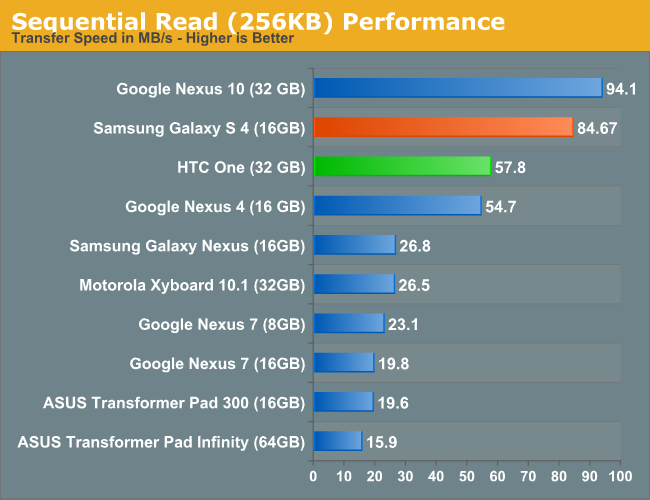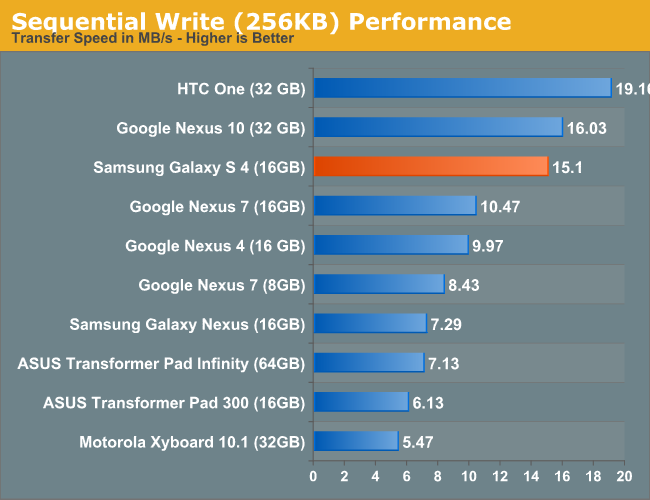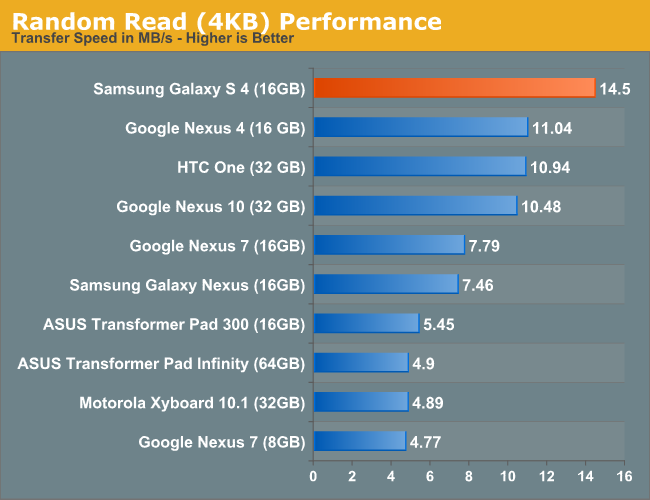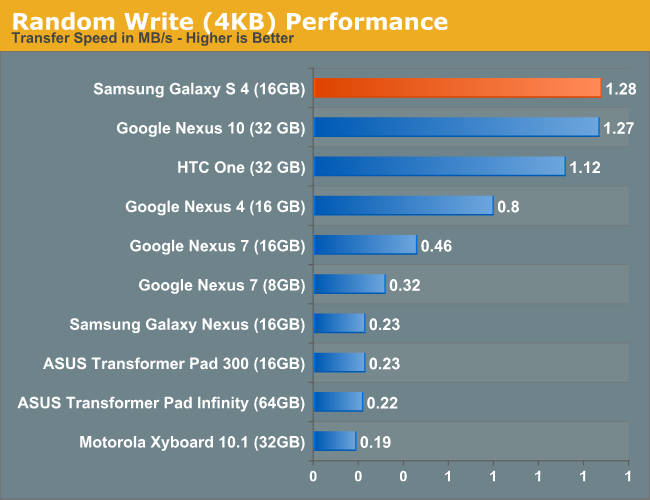Samsung Galaxy S 4 Review - Part 1
by Brian Klug on April 24, 2013 12:01 AM ESTNAND Performance
The Galaxy S 4 ships with either 16GB or 32GB of NAND on-board, but allows for expansion via a microSD card slot. The latter is a quickly disappearing feature on modern smartphones, but it remains a point of differentiation offered by Samsung. We were sampled a 16GB version of the Galaxy S 4, which arrived with 9.62GB of usable space after the OS and app pre-load.
As always we're using Androbench (with modified settings) to quantify NAND performance. Thankfully NAND performance has been steadily improving on modern smartphones/tablets, and the Galaxy S 4 is no exception. Sequential read performance actually sees a tremendous boost compared to most of the other devices in our charts here. Optimizing for sequential read performance makes a lot of sense, but it's good to see Samsung being competitive on all fronts here.
It is worth pointing out that NAND is treated very much as a commodity in these devices, and it's entirely possible that you'll see performance deviate from what we've shown here depending on what controller/NAND/firmware combination you get in your device.














335 Comments
View All Comments
slatanek - Wednesday, April 24, 2013 - link
same goes for plastic - it can crack and scratch. and it just feels like... well plastic. Samsung phones being one of the worst when it goes to quality feel. Nokia and HTC make the best "feeling" plastic phones I reconslatanek - Wednesday, April 24, 2013 - link
oh, one more thing. materials such as aluminum, glass etc. have a premium feels to them. same for polycarbonate. the difference being how these material age. my friend has an iPhone 4S with a cracked back, but it doesn't look that bad, if anything it has a vintage look and this is how premium materials age. if you have a plastic phone thats scratched or cracked it looks pretty much like garbage. and Samsung is particulalry bad at this - making their phones plastic glossy which means it reflects light in an uneven fashion and it just looks cheap. now bare in mind we're talking about flagships, they just should feel premium. I don't mind having a plastic midrange phone but at highend I expect top notch quality not only from the internals. same applies to cars - a tuned Honda may be as fast as a Ferrari but does it mean it is equally good? I don't think so. And I don't often hear Ferrari owners complaining about leather seats "cause they scratch much more than the regular ones".superflex - Wednesday, April 24, 2013 - link
So you only cracked the back cover. How about the millions of people who dropped their plastic phone and cracked the bezel or non removable shell?Do you really think people only break the removable battery covers?
lopri - Wednesday, April 24, 2013 - link
What other Snapdragon 600 devices? (plural) It's just the S4 and the One. (OK, LG has Optimus G Pro but you didn't see the markings on the chip on it and only ran browser benches with that)Brian Klug - Wednesday, April 24, 2013 - link
I have an LG Optimus G Pro here, so that's three I guess.-Brian
CrystalBay - Wednesday, April 24, 2013 - link
Hi Brian , I would have also like to see a comparison of the external speakers quality. It seems Sammy did not learn from previous Galaxys.Roland00Address - Wednesday, April 24, 2013 - link
From WikipediaAsus Padfone Infinity, HTC One, LG Optimus G Pro, Samsung Galaxy S4 (GT-I9505), ZTE Grand Memo V9815, Xiaomi Mi-2S, Pantech Vega Iron
gnx - Wednesday, April 24, 2013 - link
The Pantech Vega Iron seemed interesting, at least in terms of casing. The soon due Lenovo K900 also is supposedly a metal-alloy, though we'll wait to see.Toss3 - Wednesday, April 24, 2013 - link
Not as thorough as the HTC One review, but the best I've read thus far. THIS is how you write an objective review. Great comparisons, and detailed information about every aspect of the device.UpSpin - Wednesday, April 24, 2013 - link
Well written review.Especially your battery run down and display analysis are one-of-a-kind. Reviews on Engadget or TheVerge test it very subjectively and dim the display to 50% software brightness (which favors OLED because at 50% the OLED display is much darker than the LCD to save power, thus SGS4 scores much longer battery life, because the test is just wrong) You set it to fixed 200nits and test it very objectively.
You also highlight issues occuring with OLED (overheating and thermal issues). Personally I think OLED is the future-proof technology (I also bought a smartphone with an OLED display), but sadly the brightness is nothing spectacular and so the color accuracy. I wouldn't buy a smartphone with OLED again, at the moment.
LCD is just better, even if black isn't true black any longer. That's a small tradeoff, therefor I get outdoor usability, color accuracy and larger sub-pixels.
In the end, one can choose between HTC One (spectacular design, great display, usable camera, usable speakers, smooth and simple software) or the SGS4 (faster SoC which sadly overheats, removable battery, expandable storage, software loaded with gimmick features which sadly slow down the whole smartphone).
Because I won't use the gimmick features, rather just even switch to Cyanogenmod, bought but almost never used the second replacement battery in my current smartphone and the whole battery life improved to at least 3-4 years (my current battery is 3 years old and runs fine), never switched my SD-Card (32GB is plenty), but want it as point-and-shoot replacement and like the look of the HTC One, it's my personal favorit.